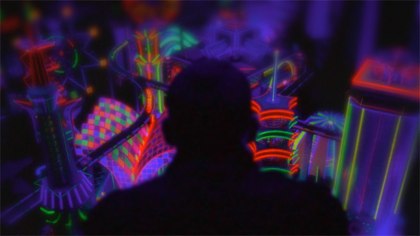TIFF 09: Enter the Void
I’m a couple days late with these write-ups. Clearly I would make a bad film critic.

Gaspar Noé‘s Irreversible was a hugely shocking and audacious film, and someone’s slipped a tab in his drink since then, as Enter the Void amps it up a few dB in scale, ambition, technique, discipline, and frustration. In a nutshell, it’s modeled on the Tibetan Book of the Dead, and follows a small-time drug dealer as he gets high, gets killed, and navigates the afterlife. It takes the concept of the point of view shot to a whole new level, and applies a strict video game perspective to each of multiple states of being. Oscar’s real life is seen in the first person, with the camera literally where his eyes are, and includes blinking, his thoughts (muttered monologue), and even his DMT-induced hallucinations. His deathbed flashbacks to his past life are shown in the third person, with the back of Oscar’s head visible in the foreground. His bodyless ghost-floating is seen from spiralling overhead shots.
These techniques are applied unrelentingly. If Oscar’s spirit wishes to follow a different friend, the camera flies across the city and finds that friend. And if a scene is to play out from this point of view, it does so, all from above, with no cutting in to closeups.
It’s a grimy neon afterlife that Noé has us enter, as Oscar the ghost drug dealer navigates a nighttime Tokyo populated by drug-addled artists, predatory dealers, and most importantly his stripper sister, with whom he has a quote unquote special bond. Oscar’s past, while not without some cliched happy moments, is scarred by a violent, traumatic incident. Noé shows us everything in unnecessary detail, as if to rub our noses in the gore of human misery.
It’s a sleazy and somewhat dull world, to be truthful. Oscar and his sister never take on the dimensions of real characters and it’s hard to form any bonds with them. I get the impression that this film is a cautionary tale, and Noé does not respect his characters. The dialogue is consistently mundane. A particularly frustrating scene toward the end, which could have been powerfully emotional, is almost laughably blunt.
Noé is anything but subtle. When I tell you that the film’s based on the Tibetan Book of the Dead, I know this not because I’ve read it or because it’s visible in the corner of the frame on a character’s shelf, but rather because the characters talk repeatedly about it, describing its contents and laying out the course of the film for those up in the cheap seats.
Also, the purity of the technique starts to get in the way of the storytelling. The need to ghost-cam fly across the city to follow different characters basically adds a 30-second whip pan every time we switch from A- to B-plot. Likewise, the playing out of long take scenes in single overhead shots gets tiresome, and bloats an already challenging film past the two-and-a-half hour mark.
That’s the frustration, that Noé doesn’t climb down from the lofty heights of the concept and the technique and make a real story out of this thing. All the same, he’s achieved some amazing shit here, and fans of formalism and/or the seedy afterlife will want to check this film out.